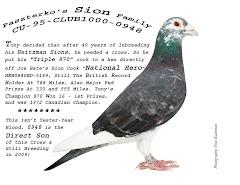Nature News
November 8, 2007
Alison Abbott
Scientists monitor the brains of homing pigeons on the wing.
Neuroscientists have fitted pigeons with recorders that pick up brain activity as the birds fly. The devices confirm that the birds really do use features from a landscape to find their way home. And researchers hope that they will be able to use the caps to unpick how birds use other types of navigational signals at different points in a journey.
Scientists are pretty sure from tracking experiments that pigeons use the Sun, Earth’s magnetic field and possibly smells as guiding cues when navigating. In 2004, Hans-Peter Lipp, a behavioural neuroscientist from the University of Zürich in Switzerland, showed that pigeons probably also use visual information. He noted that the birds tend to turn when they hit obvious landmarks like a highway exit.
Tiny trackers help to reveal a bird's thoughts in flight.H-P. Lipp
These tracking experiments collected good information about the birds' location, by fitting modern global positioning system (GPS) loggers to the pigeons’ backs. But no-one has been able to measure directly what information the pigeon are using to navigate — no one has accessed the pigeons' thoughts in flight.
"If we see a bird continuing along its path after crossing a bump in the magnetic field that would normally cause it to change direction — is this because it failed to sense the information or had a good reason to ignore it?" asks Lipp. "What’s going on in their minds?"
What are you thinking?
To find out, Lipp teamed up with Alexei Vyssotski, a biological engineer, to develop tiny electroencephalogram (EEG) recorders that can pick up electrical signals from the brain, and coupled them to GPS loggers. They fitted devices on the heads of anaesthetised pigeons that lived in a loft inland of the Italian coast, near Rome (see map). Tiny screws kept the instrument in place on the birds skulls, and served as EEG electrodes.
Which way did they go? Tracking reveals how brain patterns change over geographic features.H.-P. Lipp
Then they sailed the pigeons across the Mediterranean and released them some 50 kilometres from home. When they analysed the simultaneous GPS positions and the EEG-recorded brain waves, the team found only low and high frequency waves as the birds flew over the featureless sea — probably a sign of normal brain activity. But fluctuating levels of mid-frequency waves emerged as soon as the birds began to fly over the land. The mid-frequency waves they saw (of 12–60 Hertz) are the same as those seen in mammals when they start to pay attention to something.
To be sure that these frequencies really were relevant to the navigational task, the team did another series of experiments closer to home. The researchers released the birds 5 kilometres away from their loft, requiring them to fly over a highway exit that Lipp knew, from his 2004 study, the birds used as a major landmark. The intensity of the mid-frequency band increased when the pigeons approached and crossed this highway exit.
Invisible lines
The group presented their work yesterday at the Society for Neuroscience meeting in San Diego, California.
The methodology, says Lipp, is proof of principle that the little device can monitor brain activity related to navigation. "What we really want to use it for is to search for changes in brain activity when the pigeons cross sites that contain navigational information invisible to humans, such as electromagnetic sources, for example," he says. The team would also expect to see a flurry of activity in mid-frequency waves at that point.
The team just hopes that their instrument-laden birds, which look a little like science fiction, don't land in St Peter's Square in Vatican City and frighten anyone. So far they have only flown over this famous landmark. "At least they didn’t land among the tourists,” Lipp says.
















